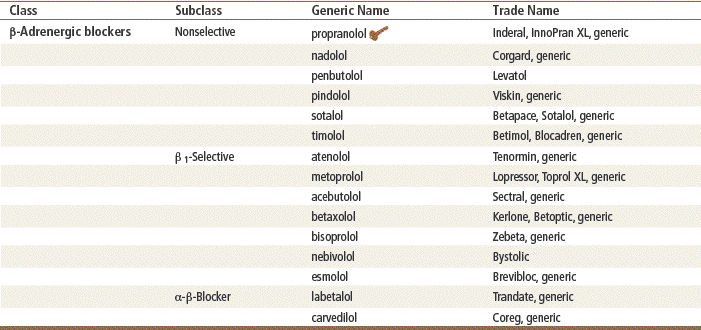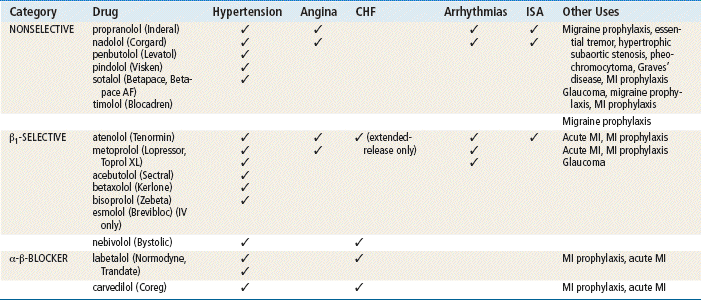http://evolve.elsevier.com/Edmunds/NP/

 Key drug. Propranolol was the first β-adrenergic blocker on the market and continues as a popular drug today.
Key drug. Propranolol was the first β-adrenergic blocker on the market and continues as a popular drug today.
Since the original introduction of propranolol in the early 1960s, β-blockers have proliferated to include a multitude of drugs. Although the drugs have basic similarities, important differences among them are notable. β-Blockers are used in a wide variety of cardiac and noncardiac conditions. It is important for the provider to pick several β-blockers and know them well, rather than trying to use all of them.
Mechanism of Action
β1-Receptors are found mainly in the heart, and stimulation from catecholamines causes an increase in heart rate, blood pressure, myocardial contractility, and AV conduction and a decrease in AV node refractoriness. β2-Receptors are also present in heart muscle but are more prominent in the lungs and in peripheral vascular smooth muscle. Activation of β1-receptors causes vasodilation and bronchodilation.
All β-blockers have a similar mechanism of action—competitive blockade of the β-adrenergic receptor. This results in decreased heart rate, myocardial contractility, blood pressure, and myocardial oxygen demand. β-Blockers also reduce the metabolic (glycogenolytic, lipolytic), myocardial stimulant, vasodilator, and bronchodilator actions of catecholamines, and they suppress renin release (Table 20-2).
TABLE 20-2
Comparison of Adrenergic Receptors
| Receptor | Site | Effect of Stimulation |
| α1 | Smooth muscle in blood vessels | Vasoconstriction |
| Stomach, intestine | Decreased motility and tone | |
| Kidney | Increased renin secretion | |
| Liver | Gluconeogenesis | |
| α2 | Smooth muscle in blood vessels | Vasodilation |
| β1 | Cardiac | Increased rate and force of contraction |
| Kidney | Increased renin secretion | |
| β2 | Bronchial, vascular, coronary arteriole, uterine smooth muscle, skeletal muscle | Vasodilation |
| Pancreas | Decreased secretion | |
| Liver | Gluconeogenesis |
As a result of β-blockade, cardiac output and heart rate are decreased. Slowing of the AV conduction system prevents an increase in cardiac automaticity and prolongs the refractory period. Decreased sympathetic peripheral outflow blocks the release of renin (carteolol, labetalol, and pindolol do not consistently inhibit renin release). BP is lowered by the action of β-blockers in decreasing cardiac output, peripheral vascular resistance, venous return, plasma volume, and renin release. The intrinsic sympathomimetic activity (ISA)-active β-blockers do not reduce renin release.
β-Blockers relieve the symptoms of angina by competitively inhibiting sympathetic stimulation of the heart, thereby reducing both heart rate and contractility. Because β-blockers reduce the heart rate–blood pressure product during exercise, symptoms of angina or the ischemic threshold during exercise are delayed or avoided.
CHF is perpetuated by an active renin-angiotensin system coupled with increased tone of the sympathetic nervous system; thus, decreasing catecholamine levels reduce cardiac congestion and left ventricular hypertrophy (LVH). β-Blockers may increase β1-Receptor sensitivity and restore inotropic response. β2-Receptors promote peripheral vasodilation.
β-Blockers prevent arrhythmia by blocking abnormal cardiac pacemaker potentials, decreasing myocardial oxygen demand, prolonging ventricular filling time, and decreasing microvascular damage of the myocardium.
Clinically significant differences between β-blockers have been noted. These agents are classified by their β-blocking selectivity (β1– or β2-α [β-blocking ability]), membrane-stabilizing activity (MSA), ISA, and pharmacokinetics. See Table 20-3 for characteristics of individual agents.
TABLE 20-3
Characteristics of Individual β-Blockers

ISA, Intrinsic sympathomimetic activity; MSA, membrane-stabilizing activity.
Selectivity (or cardioselectivity) refers to the ability of the drug to preferentially block the β1-receptors. Cardioselective β-blockers will inhibit β1-receptors while producing less inhibition of the β2-receptors that mediate bronchodilation or peripheral vasodilation. However, cardioselectivity is dose dependent, and substantial β2-blockade occurs in patients with angina for whom higher doses are used. Thus, the advantage of using β1-selectivity to reduce bronchospasm and decrease peripheral resistance may be diminished with a high-dose regimen. Most providers use selective β-blockers. Cardioselectivity is a clinically important feature of β-blockers.
Intrinsic sympathomimetic activity, or ISA, is another characteristic of β-blockers. Also known as partial agonist activity (PAA), ISA simultaneously blocks natural catecholamine while only partially activating β-receptors. Therefore, side effects such as bradycardia, bronchoconstriction, and resting peripheral vascular resistance may be minimized. ISA is not beneficial in alleviating arrhythmias and may eliminate the effectiveness of the β-blocker in the secondary prevention of MI.
Membrane-stabilizing activity, or MSA, another feature of this drug class, is described as a quinidine-like or local anesthetic effect on cardiac action potentials. High concentrations of the β-blocker are needed to reduce arrhythmias, and these often produce side effects. Thus, the significance of MSA seems to be negligible.
α-Adrenergic blocking activity is another characteristic of two drugs in this class. Labetalol and carvedilol both are nonselective β-blockers without ISA. These drugs block β- and α-receptors with a potency ratio of 4:1. The result is a reduction in heart rate and cardiac contractility (as occurs with other β-blockers), and, because of the α-blocking effects of these agents, peripheral and coronary vascular resistance is reduced. Carvedilol is used to treat patients with heart failure; however, the benefit appears to be unrelated to peripheral α-blockade.
Pharmacokinetics is a clinically important characteristic of the β-blockers that may influence their clinical usefulness and side effects. β-Blockers can be classified into two categories: those excreted by the liver and those excreted by the kidney. Propranolol and metoprolol are lipid soluble, are almost completely absorbed by the small intestine, and are largely metabolized by the liver. Because these agents are highly lipophilic, they readily enter the CNS and are responsible for side effects such as lethargy, confusion, sleep disturbance, and probably depression (this matter is under investigation). Lipid solubility of the β-blocker is a clinical necessity when migraine headache or tremor is treated. These drugs also tend to have highly variable bioavailability and relatively short plasma half-lives.
In contrast, drugs such as atenolol and sotalol are more water soluble, are poorly absorbed, are eliminated unchanged by the kidney, and generally do not cross the blood-brain barrier. They show less variance in bioavailability and have longer plasma half-lives.
β-Blockers have adverse metabolic effects; this limits their usefulness in patients with hypercholesterolemia and diabetes mellitus. β-Blockers cause moderate elevation of blood sugar, increased insulin resistance, reduced HDL cholesterol, and elevated triglycerides. They also may blunt the signs and symptoms of hypoglycemia. It has been proposed that inhibition of sympathetic activity may lead to reduction in the patient’s quality of life from fatigue, depression, or decreased exercise capacity when compared with ACE inhibitor therapy. However, this quality-of-life disadvantage with β-blockers has not been confirmed in clinical trials.
Treatment Principles
Guidelines, evidence-based findings, and cardinal treatment points can be found in Chapter 17. β-Blockers are important drugs that are known to decrease mortality. However, the choice of a β-blocker must be patient specific because of the many potential side effects that may limit compliance. Selection of agents should be limited to drugs with documented indications and known efficacy. Choose only a few β-blockers and become familiar with their use. Propranolol, atenolol, metoprolol, carvedilol, and labetalol are commonly used.
Bradyarrhythmia, AV block, heart failure, and exacerbation of peripheral vascular disease (PVD) have occurred. In diabetic patients, β-blockers may intensify hypoglycemia and prolong gluconeogenesis through inhibited release of insulin. Clinical signs and symptoms of hypoglycemia may be blocked. Clinical signs and symptoms of thyrotoxicosis may be masked, and abrupt withdrawal may precipitate thyroid storm. Symptoms of depression may be aggravated in individuals with a history of depression. Asthma and COPD may be exacerbated through the use of β-blockers.
Hypertension
β-Blockers and diuretics generally have been preferred as initial agents because they have been documented to reduce cardiovascular morbidity and mortality in long-term, controlled clinical trials. Newer studies reveal that β-blockers should not be considered as first-line drug therapy for hypertension any longer because the risk for development of diabetes mellitus is high. However, many still consider β-blockers a good first-line medication in select patients only. β-Blockers may serve as an ideal initial agent in patients with angina, arrhythmia, compensated heart failure, post-MI status, tremors, glaucoma, and vascular headache. The Seventh Report of the Joint National Committee on Prevention, Detection, Evaluation, and Treatment of High Blood Pressure (JNC 7) recommends use of a diuretic as first-line therapy for stage 1 hypertension.
Patients who should not be prescribed a β-blocker are African American patients and those with asthma or COPD, severe peripheral vascular disease, Raynaud’s phenomenon, depression, bradycardia, or second- or third-degree heart block, as well as hypoglycemia-prone diabetic patients in whom the early warning symptoms of hypoglycemia may be masked. These agents also should not be used for hypertension in the elderly unless a compelling reason such as CAD, MI, or CHF is evident. β-Blockers have not been shown to reduce the risk of stroke that accompanies the use of antihypertensive medications. See Chapter 17 for information on the management of hypertension.
Stay updated, free articles. Join our Telegram channel

Full access? Get Clinical Tree



 β-Blockers must be used with caution in patients with certain heart conditions such as heart block, sinus bradycardia, cardiogenic shock, or heart failure.
β-Blockers must be used with caution in patients with certain heart conditions such as heart block, sinus bradycardia, cardiogenic shock, or heart failure.